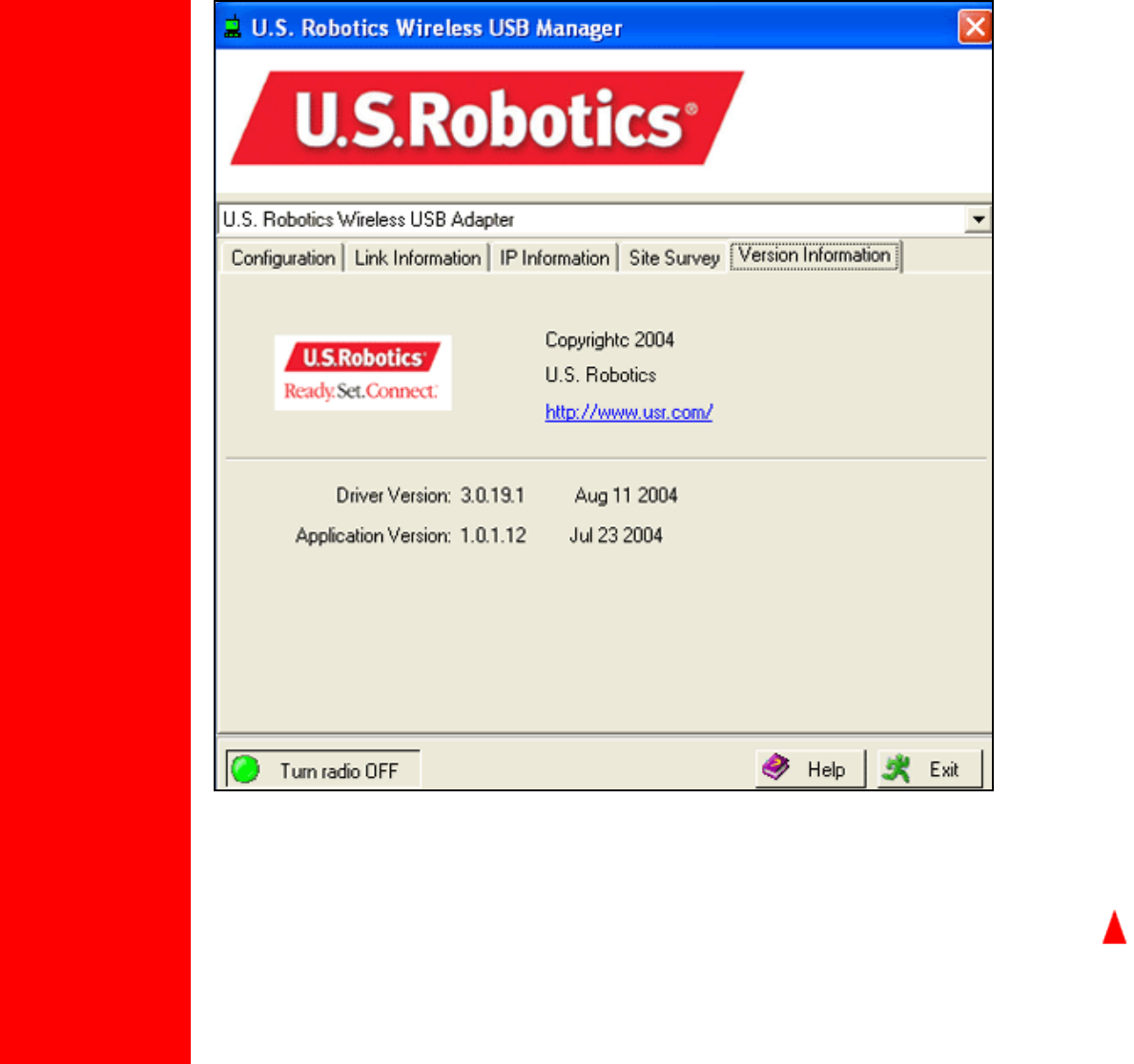Arcadyan Technology WN4501D-U5 U.S. Robotics 802.11g 54Mbps USB Adapter User Manual 802 11g 54Mbps USB Adapter User Guide
Arcadyan Technology Corporation U.S. Robotics 802.11g 54Mbps USB Adapter 802 11g 54Mbps USB Adapter User Guide
Users Manual

802.11g 54Mbps USB Adapter User Guide
Contents:
About the 802.11g
54Mbps USB Adapter >
Network Configuration
and Planning
Adapter Installation and
Configuration for
Windows 98SE/2000/Me/
XP
Navigating the Wireless
Configuration Utility
Troubleshooting
Glossary
Product Specifications
for 802.11g 54Mbps
USB Adapter
U.S. Robotics
Corporation Limited
Warranty
Regulatory Information
802.11g 54Mbps USB Adapter User Guide
About the 802.11g 54Mbps USB Adapter
The 802.11g 54Mbps USB Adapter is compatible with a USB port of any standard
Windows laptop or desktop computer. As the 802.11g 54Mbps USB Adapter is a Plug
and Play device, Windows 98SE, 2000, Me, and XP will automatically recognise it in the
installation process. Upon successful installation, the 802.11g 54Mbps USB Adapter will
be able to communicate with other home and office wireless networking products.
LED Information
(WLAN TX/RX) LED: The WLAN TX/RX LED is lighted green when the 802.11g
54Mbps USB Adapter driver is correctly installed and blinks green when traffic is being
processed. If the driver is not correctly installed, this LED will be off.
rev 1.0
9-04
R46.0764.00
file:///C|/Arcadyan/USR/SW/English/index.html2004/9/15 下午 05:34:49

802.11g 54Mbps USB Adapter User Guide
Contents:
About the 802.11g
54Mbps USB Adapter
Network Configuration
and Planning >
Adapter Installation and
Configuration for
Windows 98SE/2000/Me/
XP
Navigating the Wireless
Configuration Utility
Troubleshooting
Glossary
Product Specifications
for 802.11g 54Mbps
USB Adapter
U.S. Robotics
Corporation Limited
Warranty
Regulatory Information
802.11g 54Mbps USB Adapter User Guide
Network Configuration and Planning
The 802.11g 54Mbps USB Adapter supports legacy Ethernet LAN network configuration
options as defined by the IEEE 802 standards committee.
The 802.11g 54Mbps USB Adapter can be configured in one of the following modes:
● Infrastructure - Used for home networks, business networks, and public
hotspots when connecting to a wireless router or access point
● Ad Hoc - Used for peer-to-peer network connections when connecting directly to
another wireless adapter
NETWORK TOPOLOGY
An Infrastructure configuration extends the accessibility of a PC to a wired LAN and
doubles the effective wireless transmission range for two 802.11g 54Mbps USB
Adapters. Since the Wireless Router or Access Point is able to forward data within its
BSS, the effective transmission range in an infrastructure LAN is doubled.
The use of a unique SSID is essential. All 802.11g 54Mbps USB Adapters that are in the
wireless network must be configured with the same SSID that is used by the access
point or wireless router.
The Infrastructure Wireless LAN configuration is appropriate for enterprise-scale
wireless access to a central database or other central applications for mobile users.
An 802.11g Ad Hoc wireless LAN is a group of computers, each equipped with one
802.11g 54Mbps USB Adapter, that are connected as an independent wireless LAN.
The wireless devices in a specific 802.11g Ad Hoc wireless LAN must be configured to
share the same radio channel.
802.11g Ad Hoc wireless LAN configurations are appropriate for small departments or
SOHO environments.
The 802.11g 54Mbps USB Adapter provides access to a wired LAN for workstations. An
integrated wireless and wired LAN is called an Infrastructure configuration. A group of
802.11g 54Mbps USB Adapter users and a Wireless Router or Access Point compose a
Basic Service Set (BSS). Each 802.11g 54Mbps USB Adapter in a BSS can talk to any
computer in the wired LAN infrastructure through the Wireless Router or Access Point.
file:///C|/Arcadyan/USR/SW/English/two.html 第 1 頁 / 共 2 2004/9/15 下午 05:34:53

802.11g 54Mbps USB Adapter User Guide
Contents:
About the 802.11g
54Mbps USB Adapter
Network Configuration
and Planning
Adapter Installation and
Configuration for
Windows 98SE/2000/Me/
XP
Navigating the Wireless
Configuration Utility
Troubleshooting
Glossary
Product Specifications for
802.11g 54Mbps USB
Adapter
U.S. Robotics
Corporation Limited
Warranty
Regulatory Information
802.11g 54Mbps USB Adapter User Guide
Adapter Installation and Configuration for
Windows 98SE/2000/Me/XP
System Requirements
In order to install and use the 802.11g 54Mbps USB Adapter, your computer must
meet the following requirements:
● An available USB port
● 10 Mb free disk space for utility and driver installation
● Windows 98SE, 2000, Me, or XP
802.11g 54Mbps USB Adapter Installation
Prepare for installation
ATTENTION: You must install your software and drivers before you physically connect
the 802.11g 54Mbps USB Adapter.
Note: Your model number is 5422.
Note: For the most updated information, visit: http://www.usr.com/support
Turn on your desktop or laptop computer. Type your password if you are prompted to
do so.
Note: Be sure to find out what letter your CD-ROM drive uses before you begin
installing your new product. You will need to know this to properly install your software.
Note: During the Installation procedure, you may be prompted for your Windows
Operating system CD-ROM. Make sure you have it available in case you need it.
Note: If the 802.11g 54Mbps USB Adapter does not fit into an available USB port on
your computer because of other USB devices that are connected, use an USB
extension cable or a USB hub to connect the 802.11g 54Mbps USB Adapter.
file:///C|/Arcadyan/USR/SW/English/three.html 第 1 頁 / 共 6 2004/9/15 下午 05:34:54

802.11g 54Mbps USB Adapter User Guide
Note: If you are connecting the 802.11g 54Mbps USB Adapter to a 1.1 USB port, you
may see a message informing you that a Hi-Speed USB device is being connected to
a USB port that is not Hi-Speed. This will not affect the installation procedure.
Step One: Install your software and drivers
Insert your U.S. Robotics Installation CD-ROM into your CD-ROM drive.
Note: If your CD-ROM does not automatically launch, click Windows Start, Run, and
type D:\setup (if your CD-ROM drive uses a different letter, type that letter in place of
"D") and click OK.
The Installation CD Graphic User Interface (GUI) will appear on your screen. If
prompted, select your preferred language.
Read the license agreement and click Yes.
Select the 802.11g 54Mbps USB Adapter and click Software. Click Wireless USB
Adapter Utility and Drivers. Follow the on-screen instructions to finish the installation
procedure.
Windows Me: If you are prompted, restart your computer and continue to follow the
on-screen instructions.
Step Two: Install the 802.11g 54Mbps USB Adapter to your
computer
When you are prompted, insert the 802.11g 54Mbps USB Adapter into an available
USB port on your computer.
file:///C|/Arcadyan/USR/SW/English/three.html 第 2 頁 / 共 6 2004/9/15 下午 05:34:54

802.11g 54Mbps USB Adapter User Guide
Note: Make sure the 802.11g 54Mbps USB Adapter is fully inserted into the USB port
on your computer so that the 802.11g 54Mbps USB Adapter is detected.
Select your country. Windows will detect the new hardware. If prompted for the
location of the drivers, select Install the software automatically (Recommended)
and click Next.
Follow the on-screen instructions to complete the installation procedure.* If you are
prompted, select No, I will restart my computer later, close all open screens, and
then restart your computer.
*Note: You may receive a “Digital Signature Not Found” or “Windows Logo testing”
screen. Click Yes or Continue Anyway. U.S. Robotics has thoroughly tested this
driver in conjunction with the supported hardware and has verified compatibility with
Windows 2000, Me, and XP. Because U.S. Robotics wants its customers to take full
advantage of the network adapter’s functionality, it has made the drivers available.
Note: If you are prompted at any time for your Windows Operating System CD-ROM,
remove the U.S. Robotics Installation CD-ROM and insert your Windows CD-ROM into
the CD-ROM drive. When all of the files are copied, remove the Windows CD-ROM,
and reinsert the U.S. Robotics Installation CD-ROM.
Step Three: Connect the 802.11g 54Mbps USB Adapter to a
wireless network
file:///C|/Arcadyan/USR/SW/English/three.html 第 3 頁 / 共 6 2004/9/15 下午 05:34:54
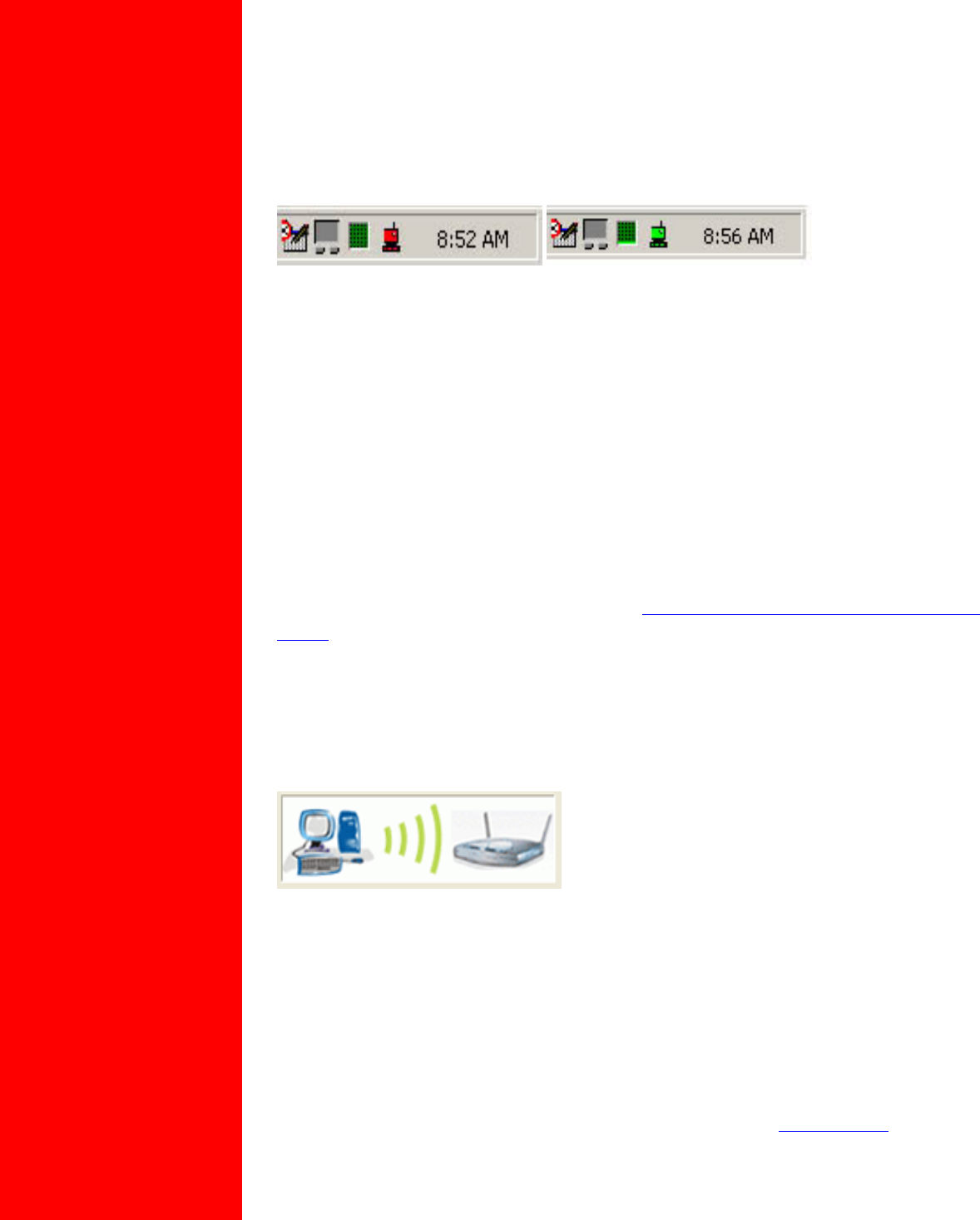
802.11g 54Mbps USB Adapter User Guide
You should now see a small icon for the Configuration Utility in the system tray by your
clock on your computer desktop. The Configuration Utility is used to change or verify
the configuration information that relates to your 802.11g 54Mbps USB Adapter. The
Configuration Utility icon will be colored to indicate the status of your wireless
connection: red for disconnected, yellow for connected with fair quality, and green for
connected with good quality. The 802.11g 54Mbps USB Adapter will automatically
connect to an available Wireless Router. You will need to verify that you are connected
to the correct Wireless Router.
Double-click the Configuration Utility icon. When the Configuration Utility launches, you
can view the connection information in the Configuration tab and in the Link
Information tab. If you are not connected to the correct Wireless Router, you can either
scan for a Wireless Router to connect to or enter the information for a specific Wireless
Router.
To scan for a Wireless Router, click the Site Survey tab. Locate the Wireless Router
you want to connect to in the list and double-click it. If you do not see the Wireless
Router in the list, click Scan to search for the Wireless Router. The default SSID of the
802.11g 54Mbps Router is USR5562.
If security is enabled in the wireless network you want to connect to or if you want to
manually enter the configuration information, you will need to set up a profile. For
information about how to do this, refer to the Navigating the Wireless Configuration
Utility section of this User Guide.
When you have connected to an existing wireless network, click the Link Information
tab. You will see a picture with a computer and a wireless device. If you see a graphic
representing signal waves between the computer and the wireless device, you are
connected to the wireless network.
If you cannot connect to the Internet or to the correct Wireless Router, verify your
configuration settings and then refer to the Troubleshooting section in this User Guide.
Congratulations! You have finished installing the 802.11g 54Mbps USB Adapter.
For troubleshooting and technical support information, refer to the Troubleshooting
section in this User Guide or to the U.S. Robotics Web site at www.usr.com
file:///C|/Arcadyan/USR/SW/English/three.html 第 4 頁 / 共 6 2004/9/15 下午 05:34:54

802.11g 54Mbps USB Adapter User Guide
Register your product
• At the Installation CD-ROM user interface, click the Support link. Click Product
Registration and then click http://www.usr.com/productreg
• You can also launch a Web browser and type in http://www.usr.com/productreg
Advanced Options
Enabling File and Print Sharing
To enable file and print sharing over the wireless network, perform the following steps
on the computers with a Wireless USB Adapter installed.
Windows 98 and Me Users: Click Windows Start, Settings, and then Control Panel.
Double-click Network and then click the File and Print Sharing button. Select both
boxes in the File and Print Sharing window and then click OK. File and print sharing is
now enabled.
Note: If your computer is connected directly to the Internet, there is a security risk if
you are not using a firewall program or some form of hardware firewall.
Windows 2000 and XP Users: File and print sharing are automatically enabled in
Windows 2000 and Windows XP in Administrator mode.
Enabling Internet Sharing
To enable Internet sharing over the wireless network, perform the following steps on
each machine that has a Wireless USB Adapter installed.
Windows 98 Users: Click Windows Start, Settings, and then Control Panel. Double-
click Add/Remove Programs and then click the Windows Setup tab. Select Internet
Tools and then click Details. Select Internet Connection Sharing and click OK. Click
Apply and the Internet Connection Sharing Wizard will launch. Click Next, select the
Wireless USB Adapter to connect to the Internet, and click Next. Click Next to create a
Client Configuration Disk, insert a blank disk into the 3.5-inch disk drive, and click OK.
This disk will be used to configure Internet sharing in Windows 98. Click Finish to
complete the configuration of Internet sharing. You will then need to restart your
computer.
Windows 2000 Users: There must be two network adapters or one network adapter
and one modem installed in order to use Internet sharing. Click Windows Start,
file:///C|/Arcadyan/USR/SW/English/three.html 第 5 頁 / 共 6 2004/9/15 下午 05:34:54

802.11g 54Mbps USB Adapter User Guide
Settings, and then Network and Dial-up Connections. Right-click the LAN
connection used to connect to the Internet and click Properties. Click the Sharing tab.
Click the box in this window to enable Internet sharing and click Apply. Right-click the
LAN connection in the list and click Properties. Select Internet Protocol and click
Properties. Click the DNS tab, write down the DNS address that is listed, and return to
the Networking and Dial-up Connections window. Right-click the wireless adapter in
the list and click Properties. Select Internet Protocol and click Properties. Click the
DNS tab and enter the same DNS address as the one listed under the LAN connection.
Windows Me Users: Click Windows Start, Settings, and then Control Panel. Double-
click Add/Remove Programs and then click the Windows Setup tab. Select
Communications and then click Details. Select Internet Connection Sharing and
click OK. Click Apply and the Home Networking Wizard will launch. Click Next and
then select Yes this computer uses the following. Select the direct connection to the
Internet from the drop-down menu and click Next. When prompted, create a Home
Networking Setup disk to be used for the configuration of Internet sharing in Windows
98, and Me. After you have created the disk, click Next. Click Finish to complete the
configuration of Home Networking. You will then need to restart your computer.
file:///C|/Arcadyan/USR/SW/English/three.html 第 6 頁 / 共 6 2004/9/15 下午 05:34:54
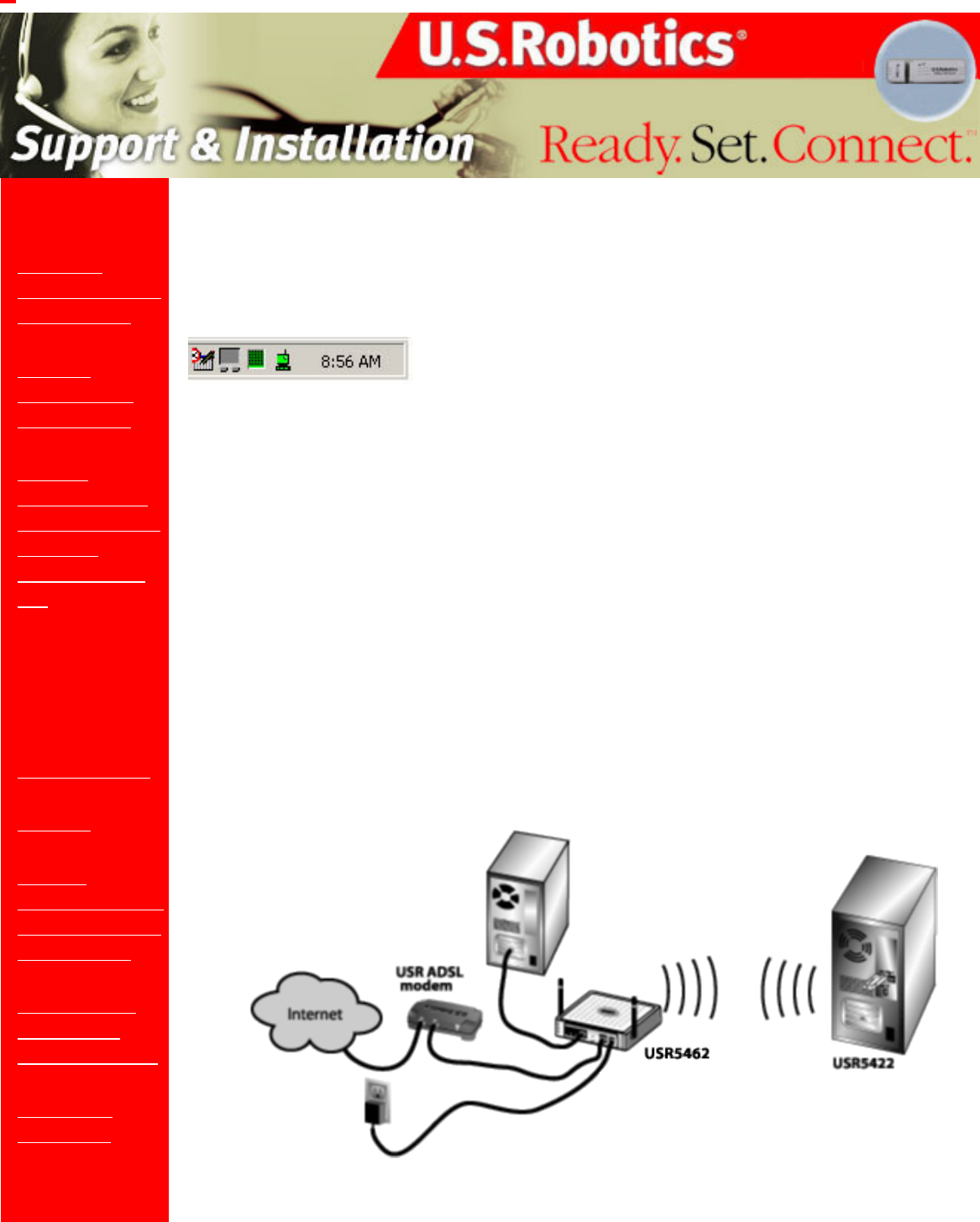
802.11g 54Mbps USB Adapter User Guide
Contents:
About the
802.11g 54Mbps
USB Adapter
Network
Configuration
and Planning
Adapter
Installation and
Configuration for
Windows
98SE/2000/Me/
XP
Navigating the
Wireless
Configuration
Utility
Troubleshooting
Glossary
Product
Specifications for
802.11g 54Mbps
USB Adapter
U.S. Robotics
Corporation
Limited Warranty
Regulatory
Information
802.11g 54Mbps USB Adapter User Guide
Navigating the Wireless Configuration Utility
Wireless Configuration Utility
The following section describes the various functions of the Wireless Configuration Utility. This
utility provides quick access to all adapter settings.
After installation is complete, the Wireless Configuration Utility icon will appear in the taskbar on
the right side near the clock. Double-clicking the icon in the task will open the Wireless
Configuration Utility main menu, providing quick access to all adapter settings. The Configuration
Utility icon will be colored to indicate the status of your wireless network: red for disconnected and
green for connected.
There are two types of network connections you can make with the 802.11g 54Mbps USB
Adapter: Infrastructure and Ad Hoc.
● If you will be connecting to a wireless router or access point, you will need to create an
Infrastructure connection.
● If you will be connecting directly to another wireless adapter, you will need to create an Ad
file:///C|/Arcadyan/USR/SW/English/four.html 第 1 頁 / 共 15 2004/9/15 下午 05:34:56
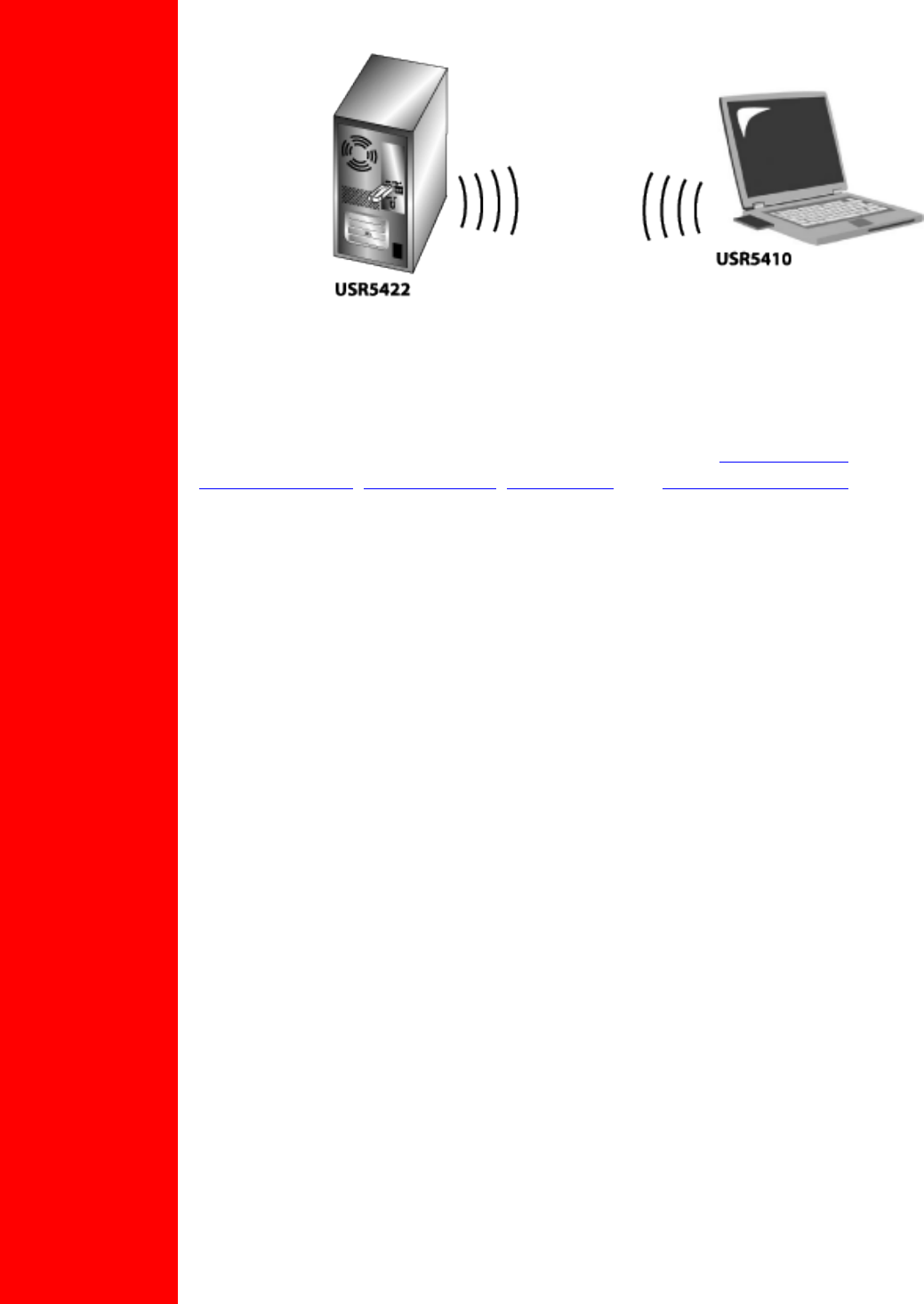
802.11g 54Mbps USB Adapter User Guide
Hoc connection.
There are five sections to the Wireless Configuration Utility: Configuration,
Link Information, IP Information, Site Survey, and Version Information.
At the bottom of each page you will see a button that says either Turn Radio On or Turn Radio
Off.
● If it says Turn Radio Off, the wireless functionality of the 802.11g 54Mbps USB Adapter is
enabled. Clicking this button will disable it.
● If it says Turn Radio On, the wireless functionality of the 802.11g 54Mbps USB Adapter is
disabled. Clicking this button will enable it.
If you make any changes to any of the settings on the Utility pages, click Apply in order for the
changes to be implemented. Click Exit when you are finished viewing the information or making
any changes.
Configuration
In the Configuration tab, you can create or edit the connection settings of the 802.11g 54Mbps
USB Adapter.
file:///C|/Arcadyan/USR/SW/English/four.html 第 2 頁 / 共 15 2004/9/15 下午 05:34:56
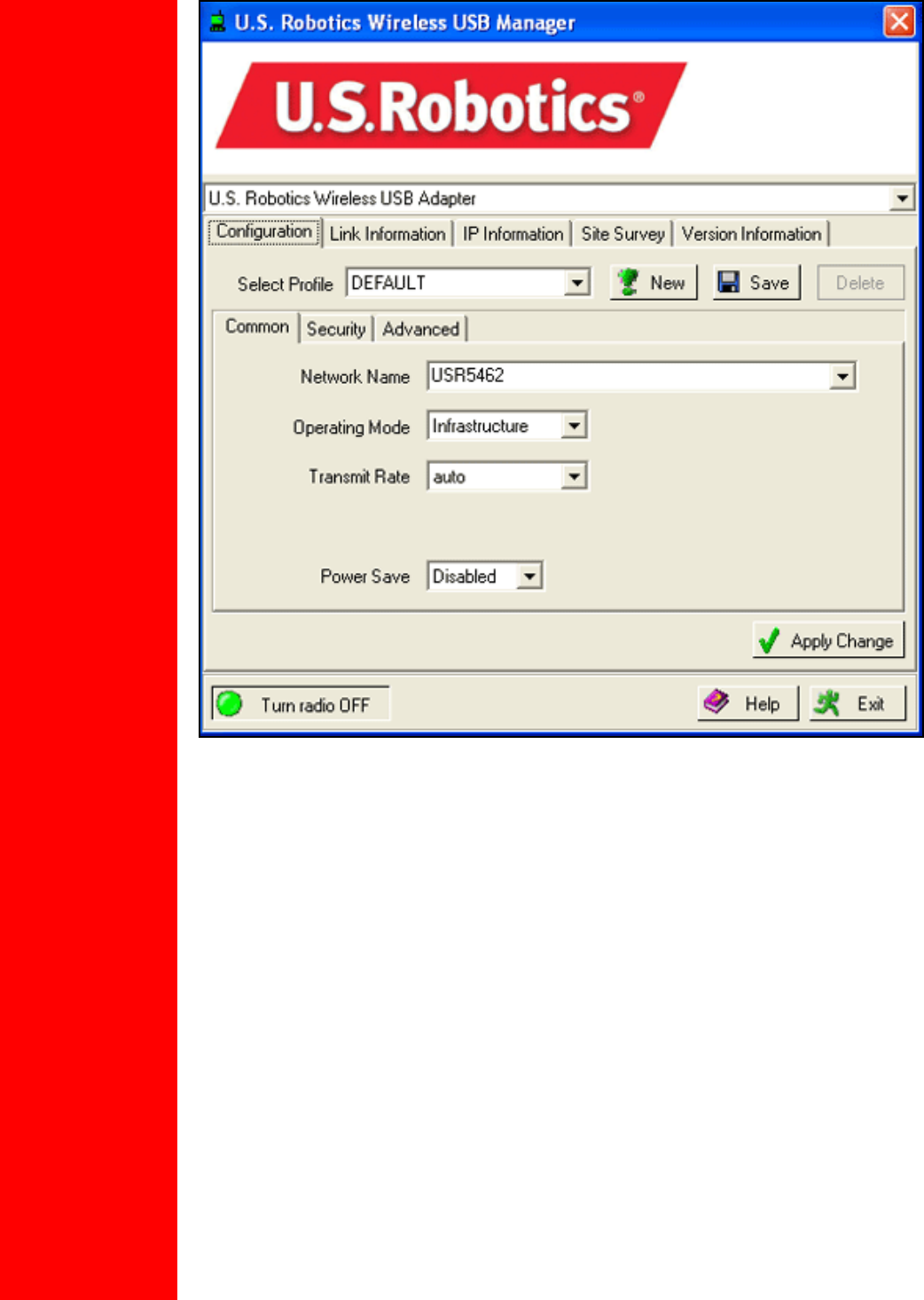
802.11g 54Mbps USB Adapter User Guide
If you will be connecting to different wireless networks in different areas, you can create profiles
so that you can easily switch between networks depending on your location or situation.
If you attempt to connect to a network that has security settings enabled, you will need to create a
profile and supply the necessary information. Refer to your wireless router's or access point's
documentation for instructions on how to locate the necessary security information.
You must have the following configuration information for your network before you make a
wireless connection:
● SSID: This is the network name
● Network Type: Infrastructure or Ad Hoc
If security is enabled on the network, you will also need the following information:
● Authentication Mode: Open System or Shared Key
● Encryption: 40/64bits WEP, 104/128bits WEP, or WPA-PSK
● Data Encryption Key Type: ASCII (Alphanumeric), HEX (Hexadecimal), or Passphrase
● Encryption Key
file:///C|/Arcadyan/USR/SW/English/four.html 第 3 頁 / 共 15 2004/9/15 下午 05:34:56

802.11g 54Mbps USB Adapter User Guide
You can create a new profile by clicking New next to the Select Profile line and then entering a
Profile Name in the window that opens up. After creating a profile, you can select it at any time in
the dropdown menu for Select Profile. If you have Default selected, the 802.11g 54Mbps USB
Adapter will not use any specific configuration information when attempting to connect to a
network. If you select a profile you created, you will only be able to connect to a network that has
the same configuration information.
If you create a profile and supply some unique configuration information, click Save after you
have changed the configuration settings. This will save the changes to the new profile.
If you want to remove a profile you have created, select it and then click Delete.
If you select a new profile, click Apply for the change to take effect.
If you make any changes to the configuration settings or select a new profile, click Apply for the
new settings to take effect.
There are three areas within the Configuration tab where you can make changes to the settings:
Common, Security, and Advanced.
Common
In this area you can select the SSID of a detected network, or type ANY to be able to connect to
any available network.
You will then need to select the Operating Mode: either Infrastructure or Ad Hoc.
Infrastructure: Select this mode if you will be connecting to a wireless router or
access point. Infrastructure mode provides additional features, such as power
saving and extended range.
file:///C|/Arcadyan/USR/SW/English/four.html 第 4 頁 / 共 15 2004/9/15 下午 05:34:56

802.11g 54Mbps USB Adapter User Guide
Ad hoc: Select this mode if you will be connecting to another wireless device
without the use of a wireless router or access point.
For Transmit Rate, you can select the speed at which you want to connect to the wireless
network. If you select auto, the 802.11g 54Mbps USB Adapter will connect at the highest possible
speed for the chosen network.
For Power Save, you can select either Disabled or Enabled. If you select Enabled on a laptop
computer, the Power Save mode can reduce power consumption by the 802.11g 54Mbps USB
Adapter and extend the battery life of your laptop. By default, Disabled is selected.
Security
In the Security area, you can specify the security settings of the 802.11g 54Mbps USB Adapter.
On each page, you will see a button that says either Turn Security On or Turn Security Off.
● If it says Turn Security Off, click this button to disable the the wireless security functions
of the 802.11g 54Mbps USB Adapter.
● If it says Turn Security On, click this button to enable the wireless security functions of the
802.11g 54Mbps USB Adapter.
For Authentication Type, you can select either WPA-PSK or WEP.
file:///C|/Arcadyan/USR/SW/English/four.html 第 5 頁 / 共 15 2004/9/15 下午 05:34:56
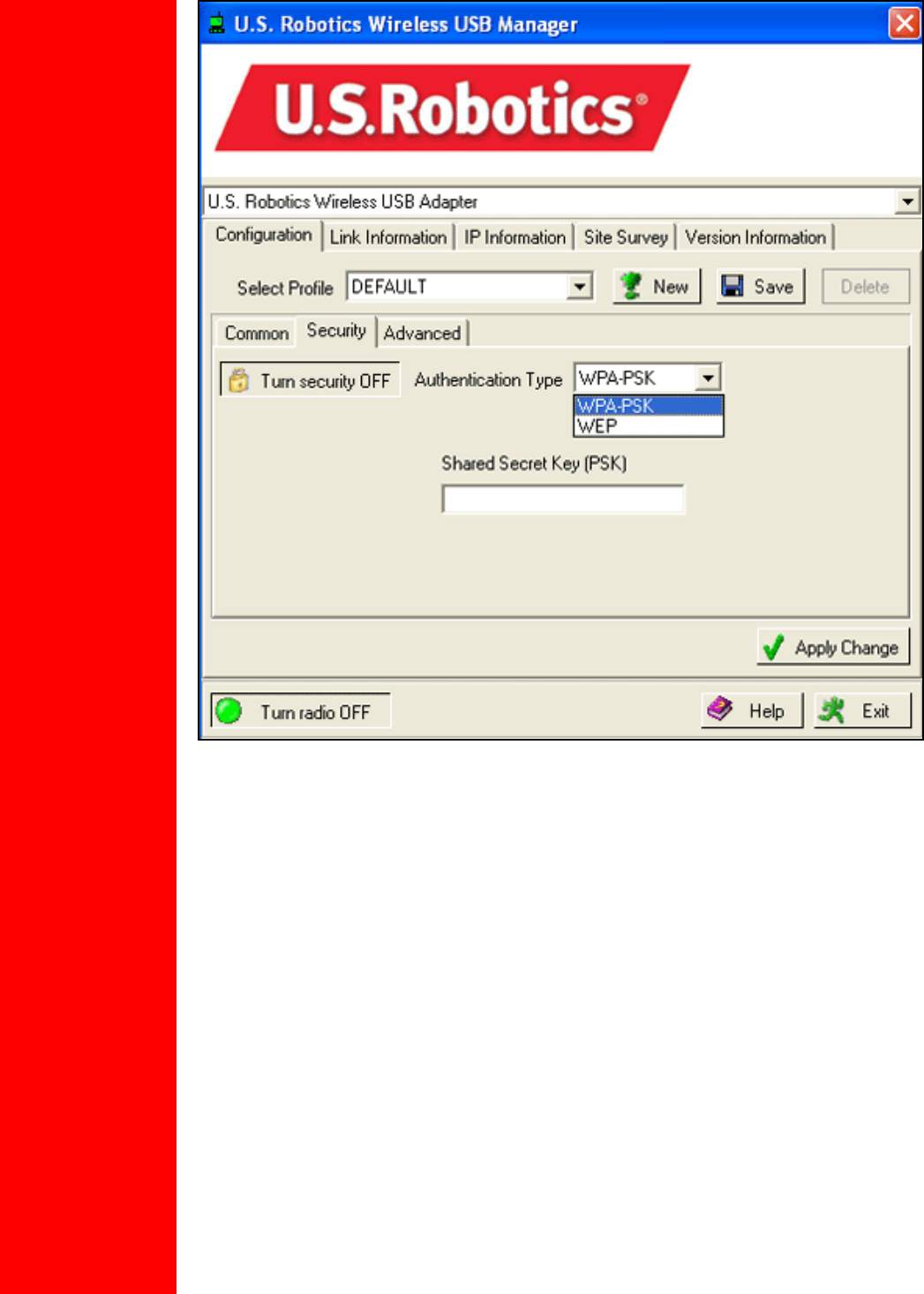
802.11g 54Mbps USB Adapter User Guide
WEP
file:///C|/Arcadyan/USR/SW/English/four.html 第 6 頁 / 共 15 2004/9/15 下午 05:34:56
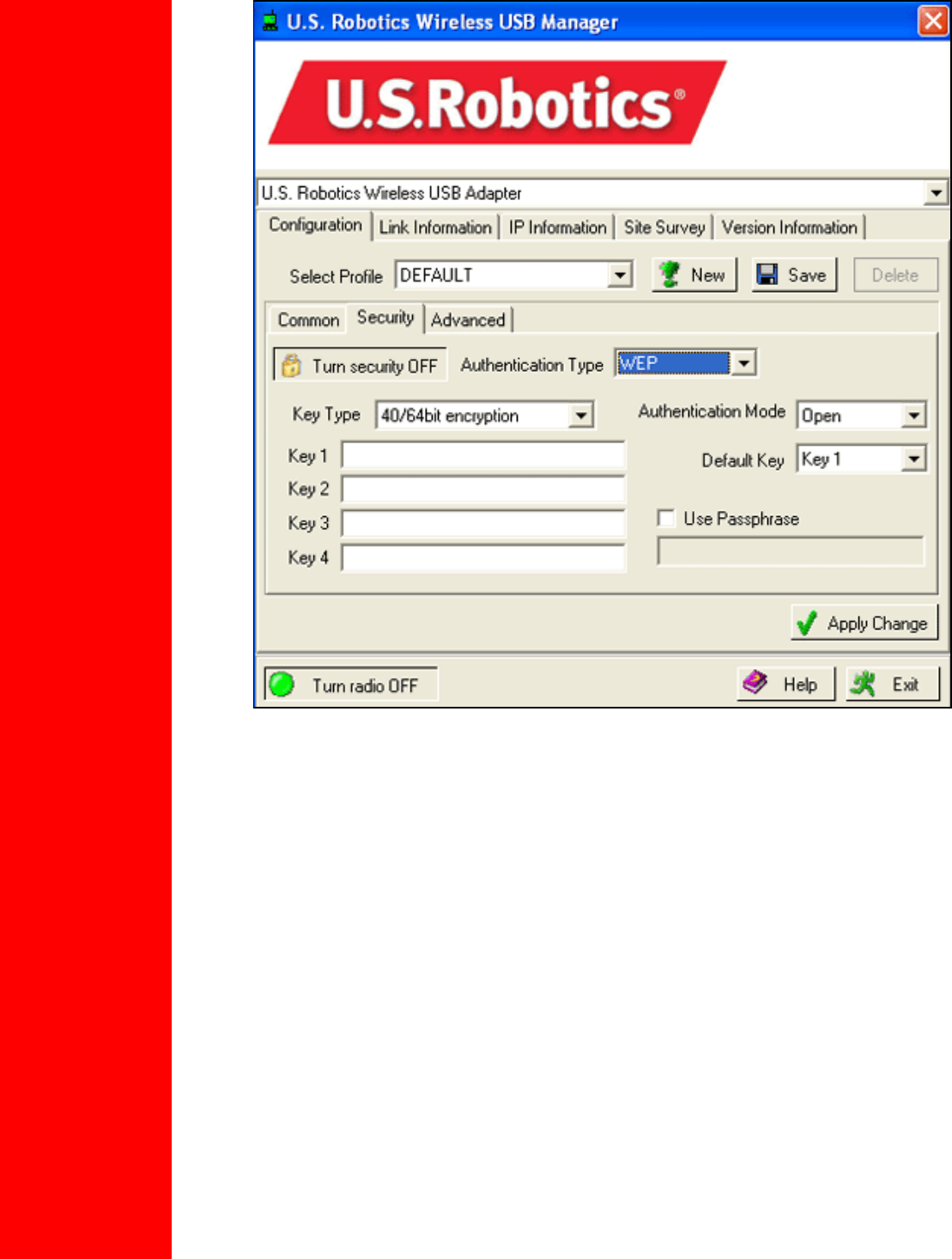
802.11g 54Mbps USB Adapter User Guide
WEP is an encryption scheme that is used to protect your wireless data
communications. WEP uses a combination of 40/64-bit keys or 104/128-bit keys to
provide access control to your network and encryption security for every data
transmission. To decode a data transmission, each wireless client on the network
must use an identical 64-bit or 128-bit.
If you select WEP, you will need to select the Authentication Mode. You can
select either Open or Shared. The default setting of the 802.11g 54Mbps Router is
Open.
You can set the Default Key to either 1, 2, 3, or 4. If you enter multiple Keys, this
will determine which one should be used. This is a simple way to switch between
different networks that have the same configuration information except for the WEP
key.
You will then need to select the Key Type from one of the following: 40/64bit
encryption, 40/64bit encryption (ASCII), 104/128bit encryption, or 104/128bit
encryption (ASCII). If you select one of the Key Type options that does not say
ASCII, it is a Hex (Hexidecimal) Key Type.
file:///C|/Arcadyan/USR/SW/English/four.html 第 7 頁 / 共 15 2004/9/15 下午 05:34:56
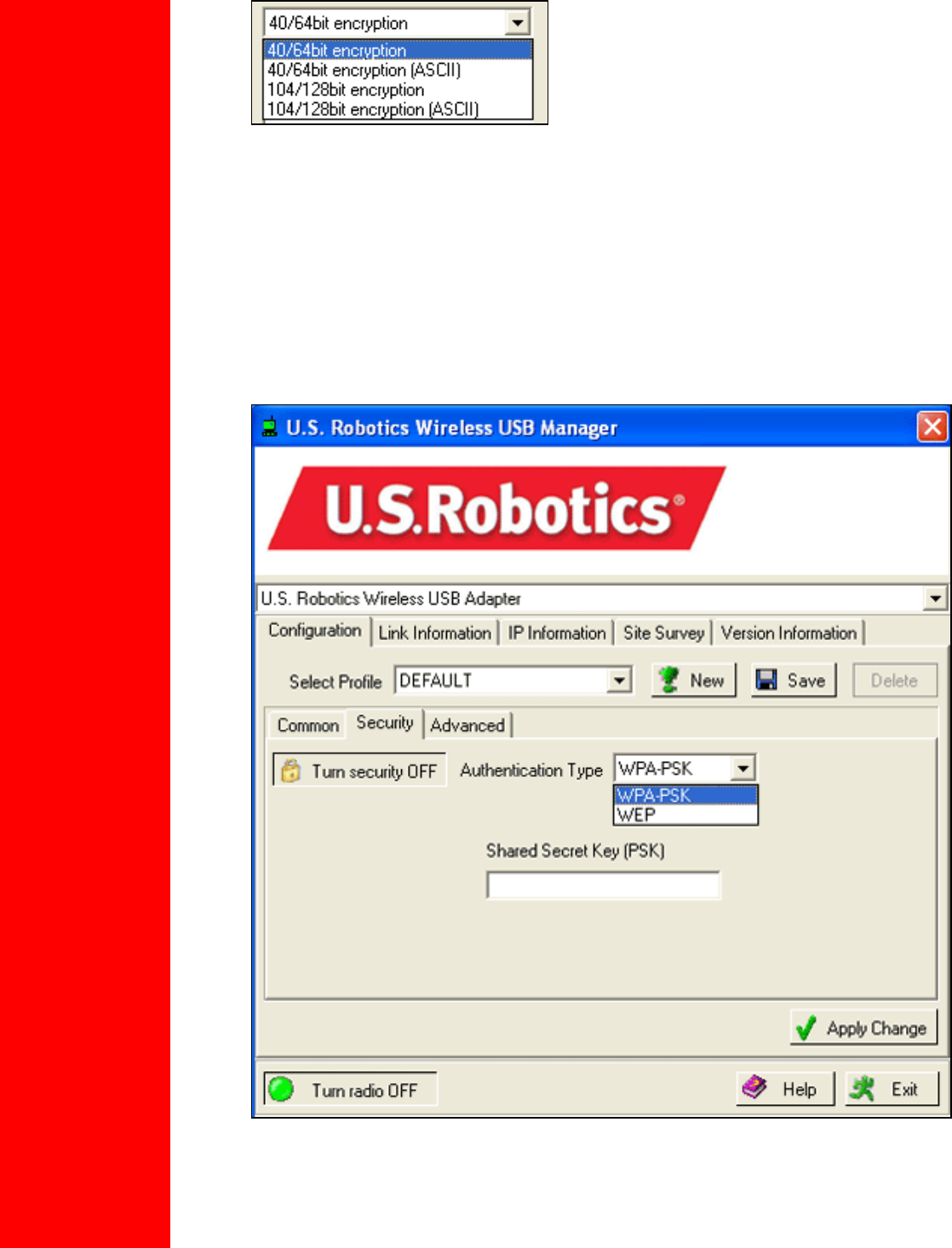
802.11g 54Mbps USB Adapter User Guide
You can also select Use Passphrase and then enter a Passphrase to use in the
place of keys. If you choose this option, the wireless network or wireless devices
you are going to connect to must also support this option.
When you are finished entering the information, click Apply.
WPA-PSK
If you select WPA-PSK, you will then need to enter a Shared Secret Key (PSK).
The Key should be between 8 and 63 characters long.
WPA’s use of keys is very similar to WEP, but the key is only used once to start the
file:///C|/Arcadyan/USR/SW/English/four.html 第 8 頁 / 共 15 2004/9/15 下午 05:34:56

802.11g 54Mbps USB Adapter User Guide
process. Once communication is established, the key will randomly change. This
provides a higher level of security. It is recommended that you use the most secure
mechanism available on your 802.11g 54Mbps USB Adapter.
Note: WPA-PSK can only be used if the wireless network you want to connect to is
capable of employing WPA-PSK as an authentication mode. Many older wireless
devices may not be able to use WPA-PSK, so this should be verified before WPA-
PSK is selected. Non-matching authentication modes will keep you from being able
to connect to a wireless network.
When you have entered the information, click Apply.
Advanced
It is recommended that you don't change any of these settings unless directed to by a network
administrator.
In the Advanced area, you can modify the following fields:
file:///C|/Arcadyan/USR/SW/English/four.html 第 9 頁 / 共 15 2004/9/15 下午 05:34:56

802.11g 54Mbps USB Adapter User Guide
● RTS Threshold
● Fragment Threshold
● Preamble Type
● Transmit Power
RTS Threshold is the packet size threshold at which a Request to Send (RTS) signal must be
sent to the wireless receiving unit prior to the wireless sending unit opening communications. The
default is 2347.
Fragment Threshold determines how large a fragment is that is being sent before it is broken
into multiple fragments to increase throughput. The default is 2346.
Preamble Type defines the length of the CRC (Cyclic Redundancy Check) block for
communication between the 802.11g 54Mbps USB Adapter and the wireless router or access
point. This is used to detect data transmission errors. If your wireless network has a lot of traffic,
you should select Short & Long.
Transmit Power determines the radio level output of the 802.11g 54Mbps USB Adapter. This
determines the extent of the range that the 802.11g 54Mbps USB Adapter will emit a signal to and
receive a signal from. If you want a smaller transmission range for security purposes and to
reduce interference, select a lower level. If you want a larger transmission range, select a higher
level.
When you are finished modifying these settings, click Apply.
Link Information:
The Link Information area shows the network information and a graphical representation of your
connection status.
file:///C|/Arcadyan/USR/SW/English/four.html 第 10 頁 / 共 15 2004/9/15 下午 05:34:56

802.11g 54Mbps USB Adapter User Guide
You will see a picture with a computer and a wireless device. If you see a graphic representing
signal waves between the computer and the wireless device, you are connected to the wireless
network.
If you see a large X between the two icons, you are not connected to a wireless network.
The first lines tell you the SSID (Network Name) of the wireless network you are connected to and
the Base Station Name ID (MAC address) of the wireless router or access point that you are
connected to. The Channel line tells you what channel you are wirelessly communicating on. The
Current Connection Speed line tells you at what speed you are currently connected. The
Throughput area tells you the amount of information fragments that have been transmitted and
received on your wireless network connection. The Signal Strength bar indicates how well you
are connecting to a wireless network. The higher percentage that is listed, the better your
connection is.
file:///C|/Arcadyan/USR/SW/English/four.html 第 11 頁 / 共 15 2004/9/15 下午 05:34:56

802.11g 54Mbps USB Adapter User Guide
IP Information
In this screen you can view the following information for your 802.11g 54Mbps USB Adapter:
● IP Address This is the address that is assigned to a client on a network.
● IP Netmask This is the address used to mask the internal IP addresses of a network from
anyone outside of the network. 255.255.255.0 is commonly used and is the binary
equivalent of eight 0's.
● Gateway This is the address assigned to a network device that is used to access the
Internet or another network.
● Host Name This is the name of the computer that your 802.11g 54Mbps USB Adapter is
installed on.
Click Release if you want to release the IP Address that has been assigned to the 802.11g
54Mbps USB Adapter. Click Renew to obtain a new IP Address for the 802.11g 54Mbps USB
Adapter from a DHCP server
You can also see a graph that represents the flow of information to and from your 802.11g
54Mbps USB Adapter. Under the graphic, you can select either both, incoming, or outgoing.
Incoming (Receiving) shows you just the information coming into the 802.11g 54Mbps USB
Adapter. Outgoing (Transmitting) shows you just the information going out from the 802.11g
file:///C|/Arcadyan/USR/SW/English/four.html 第 12 頁 / 共 15 2004/9/15 下午 05:34:56

802.11g 54Mbps USB Adapter User Guide
54Mbps USB Adapter. Both shows the incoming information and the outgoing information.
Site Survey:
Selecting this tab opens the Site Survey area.
You will see a list of the available wireless networks to which you can connect. Double-click the
appropriate network to connect to it. If you do not see the desired wireless network, click Scan to
perform another search of the area.
If you still do not see the desired wireless network when you perform a Site Survey, try creating a
file:///C|/Arcadyan/USR/SW/English/four.html 第 13 頁 / 共 15 2004/9/15 下午 05:34:56

802.11g 54Mbps USB Adapter User Guide
profile with the necessary connection information for the appropriate wireless network and then
selecting this profile. Refer to the Profile section in this User Guide for more information about
creating a profile.
The first column is the SSID (Network Name) column, which lists the SSID, or Network Name, for
each available wireless network that does not have SSID Broadcast disabled. If an SSID is not
listed, that means SSID Broadcast is disabled for that device and you will need to know specific
security information to connect to it.
The second column is the MAC Address column. This is a list of the MAC addresses of each
available wireless network.
Next to the MAC Address list is the Channel column. This lets you know what channel each
wireless network is operating on. The 802.11g 54Mbps USB Adapter is compatible with both
802.11g products and the earlier 802.11b versions.
The next column is the Encryption column. If a wireless network has encryption enabled, you will
see a gold key on the network line. The only way to connect to a network that has encryption
enabled is to create a Profile using the specific security information for that network.
Next to this column is the Signal column. This provides a percentage indicator of how strongly
you are receiving the signal from each wireless network to which you can connect.
The last column is the Network Type column. You will see one of two icons in this column
indicating if the network is in Infrastructure mode or in Ad Hoc mode. If it is an Infrastructure
network, you will see an icon representing a wireless router or access point. If it is an Ad Hoc
network, you will see an icon representing a wireless adapter.
If you attempt to connect to a network that has security settings enabled, you will need to create a
profile and supply the necessary information. Refer to your wireless router's or access point's
documentation for instructions on how to locate the necessary security information. Some
examples of security information you may need are the SSID, the Authentication Mode, and the
Encryption Level.
Version Information:
Within this section, you can view the version information for your 802.11g 54Mbps USB Adapter.
Click the Web link to go to the U.S. Robotics Web site, where you can see if any driver or utility
updates are available.
file:///C|/Arcadyan/USR/SW/English/four.html 第 14 頁 / 共 15 2004/9/15 下午 05:34:56

802.11g 54Mbps USB Adapter User Guide
Contents:
About the 802.11g
54Mbps USB Adapter
Network Configuration
and Planning
Adapter Installation and
Configuration for
Windows 98SE/2000/Me/
XP
Navigating the Wireless
Configuration Utility
Troubleshooting
Glossary
Product Specifications
for 802.11g 54Mbps
USB Adapter
U.S. Robotics
Corporation Limited
Warranty
Regulatory Information
802.11g 54Mbps USB Adapter User Guide
Troubleshooting
I plugged in the 802.11g 54Mbps USB Adapter but I do not see the Configuration
Utility icons.
Possible Solution:
If you installed the 802.11g 54Mbps USB Adapter without installating the software and
drivers first, you will not see the Configuration Utlity. If the Installation CD-ROM is in your
CD-ROM drive, remove it. Insert the Installation CD-ROM into your CD-ROM drive,
select your product, and then click Software. Click 802.11g 54Mbps USB Adapter
Utility and Drivers. Follow the on-screen instructions to finish the installation procedure.
If you are prompted, restart your computer.
Windows could not locate the drivers for the 802.11g 54Mbps USB Adapter.
Possible Solution:
The software must be installed before the 802.11g 54Mbps USB Adapter is connected to
your computer. Click Cancel on the Windows driver screen, unplug the 802.11g 54Mbps
USB Adapter from your computer, and perform the Installation Procedure again, making
sure to install the software and drivers first.
I cannot connect to the Internet.
Possible Solution:
Check the Configuration Utility icon for the 802.11g 54Mbps USB Adapter in the system
tray to confirm the connection status. If you are connected to your Wireless Router, the
icon will be green or yellow. If the icon is red, open the Configuration Utility and scan the
area so that you can connect to the correct wireless network.
Possible Solution:
Try performing the ping procedure to make sure you can connect with different areas of
the wireless network and the Internet. If at any time during the ping procedure you do
not receive a return message for a successful ping, this means that you cannot connect
to that IP address. After you have made the corrections, continue with the ping
procedure.
1. Click Windows Start and then click Run. In the Run dialog box, Windows 98 and
Me users should type command and click OK. Windows 2000 and XP users
should type cmd and click OK.
2. At the command prompt, type Ping 127.0.0.1 This is your local host address and
this will ensure that the TCP/IP protocol is installed and functioning properly. If
you cannot complete this ping, reinstall the TCP/IP protocol on your computer.
Refer to your operating system’s documentation for instructions.
file:///C|/Arcadyan/USR/SW/English/five.html 第 1 頁 / 共 5 2004/9/15 下午 05:34:58

802.11g 54Mbps USB Adapter User Guide
3. Type Ping followed by your IP address. To determine your IP address, refer to
the previous Possible Solution. This will ensure that your computer is responding
to requests and that the 802.11g 54Mbps USB Adapter is properly installed. If
you cannot complete this ping, uninstall the 802.11g 54Mbps USB Adapter and
repeat the installation procedure.
4. Type Ping followed by your gateway address to check the communication with
your gateway. The default gateway address is the IP address of your wireless
router or access point. Check your Wireless Router to verify this address. This
will ensure that you can connect to the Wireless Router. If you cannot complete
this ping, make sure your wireless settings are correct and that the 802.11g
54Mbps USB Adapter is fully inserted into a USB port on your computer.
5. Type Ping followed by the outside Internet address that is provided by your ISP.
This procedure will ensure that your wireless network can connect to the Internet.
If you cannot complete this ping, verify your Internet connection between your
modem and your wireless router or access point.
6. Type Ping followed by your known DNS server address. This will allow you to
resolve valid Internet host names to IP addresses and to verify that you can
access the Internet.
Security is enabled on my Wireless Router and my 802.11g 54Mbps USB Adapter
cannot connect.
Possible Solution:
The 802.11g 54Mbps USB Adapter supports 64 and 128 bit encryption. Verify that all of
the security features you have entered for the profile of your 802.11g 54Mbps USB
Adapter match the settings for your Wireless Router. For more information about setting
up connection profiles and security features, refer to the Navigating the Wireless
Configuration Utility section of this User Guide.
Possible Solution:
If you created a Profile Setting, unplug the 802.11g 54Mbps USB Adapter and then plug
it back in.
The U.S. Robotics Installation CD-ROM did not automatically launch when I
inserted the Installation CD-ROM.
Possible Solution:
Some programs may keep the autolaunch feature of the Installation CD-ROM from
beginning. Close any open applications and reinsert the Installation CD-ROM. If your CD-
ROM still does not automatically launch, click Windows Start, Run, and type D:\setup (if
your CD-ROM drive uses a different letter, type that letter in place of “D”) and click OK.
I accidentally clicked Cancel during the installation procedure.
Possible Solution:
Remove and reinsert the U.S. Robotics Installation CD-ROM into your CD-ROM drive.
Repeat the installation procedure of the software before you install any hardware.
My computer does not recognise the 802.11g 54Mbps USB Adapter.
Possible Solution:
The 802.11g 54Mbps USB Adapter may not be properly connected. Make sure the
802.11g 54Mbps USB Adapter is fully inserted into the USB Port on your computer.
The 802.11g 54Mbps USB Adapter does not work properly, and I may need to
uninstall the device.
Possible Solution:
file:///C|/Arcadyan/USR/SW/English/five.html 第 2 頁 / 共 5 2004/9/15 下午 05:34:58

802.11g 54Mbps USB Adapter User Guide
Check to be certain the 802.11g 54Mbps USB Adapter is not in use before removing it.
The computer may lock up if the 802.11g 54Mbps USB Adapter is removed while in use.
If the 802.11g 54Mbps USB Adapter is not functioning correctly, perform the following
steps:
Windows XP Users: Click Windows Start, All Programs, 802.11g
Wireless USB Adapter Utility, and then Uninstall.
Windows 2000 Users: Click Windows Start, Programs, 802.11g
Wireless USB Adapter Utility, and then Uninstall.
I uninstalled the Configuration Utility and my computer doesn’t detect the 802.11g
54Mbps USB Adapter when I attempt to reinstall the Configuration Utility.
Possible Solution:
If you uninstalled the Configuration Utility and then reinstalled it, you will need to unplug
and then plug back in the 802.11g 54Mbps USB Adapter. Your computer will then detect
the 802.11g 54Mbps USB Adapter.
When I perform a Site Survey, I cannot locate the wireless network to which I want
to connect.
Possible Solution:
If you do not see the correct wireless network, click Scan.
If you still do not see the correct wireless network when you perform a Site Survey, try
creating a profile using the necessary connection information for the appropriate wireless
network, selecting the profile, and then clicking Apply in the Configuration tab. Refer to
the Profile section in the Navigating the Wireless Configuration Utility section of this
User Guide for more information about creating a profile.
Are You Still Having Problems?
1. Go to the U.S. Robotics Web site at www.usr.com
Many of the most common difficulties users experience have been addressed in the
FAQ and Troubleshooting Web pages for your specific product.
2. Call the U.S. Robotics Technical Support Department.
Technical questions about U.S. Robotics products can also be answered by technical
support specialists.
Country Voice Online Support Hours
United
States (888) 216-2850 http://www.usr.com/emailsupport 9:00 A.M. - 5:00 P.M.,
Monday - Friday CST
Canada (888) 216-2850 http://www.usr.com/emailsupport 9:00 A.M. - 5:00 P.M.,
Monday - Friday CST
file:///C|/Arcadyan/USR/SW/English/five.html 第 3 頁 / 共 5 2004/9/15 下午 05:34:58
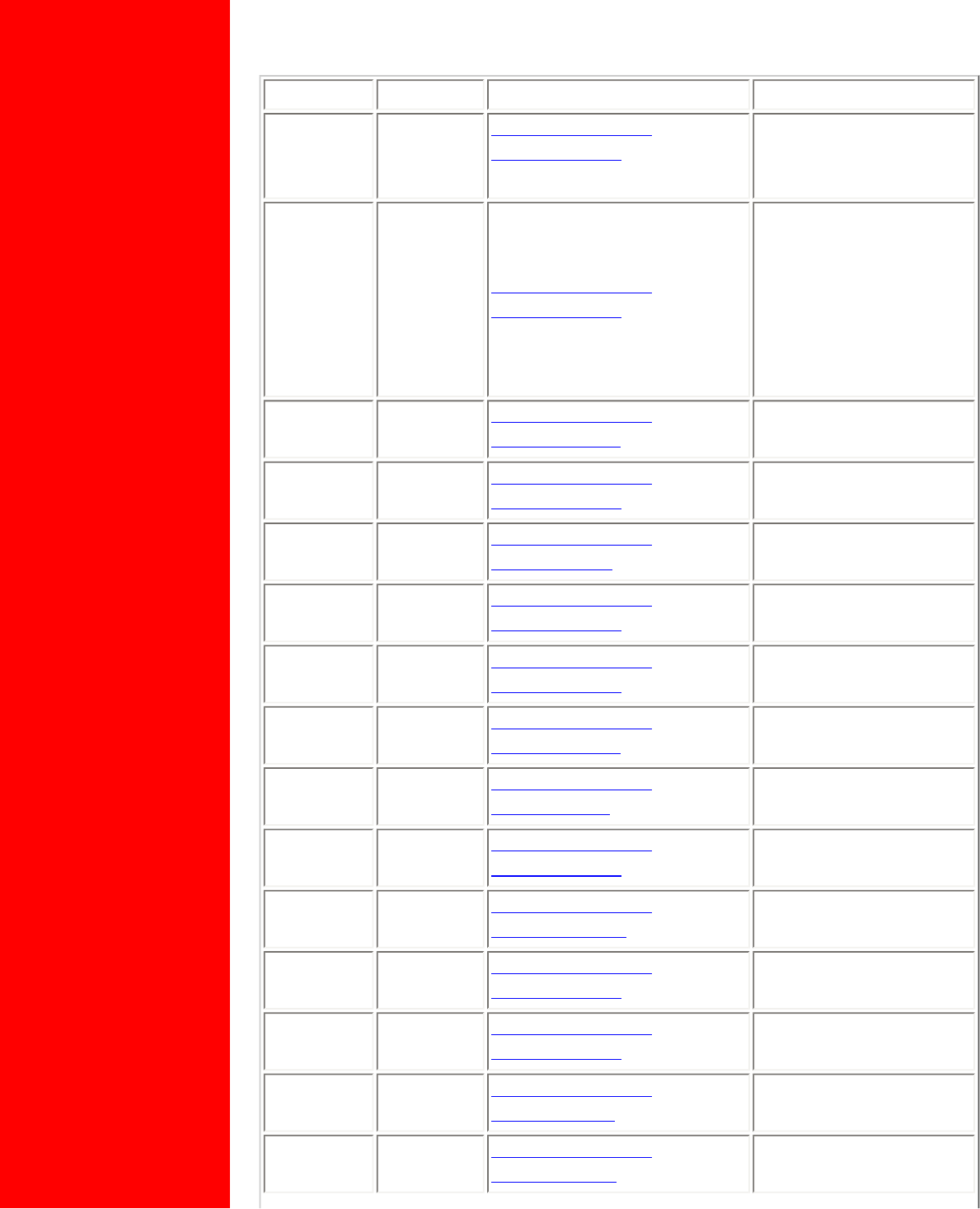
802.11g 54Mbps USB Adapter User Guide
Country Telephone Online Hours
Austria 07110
900116
http://www.usr.com/
emailsupport/de 9:00 - 17:00
Monday - Friday
Belgium
(Flemish)
(French)
+32 (0) 7
023 3545
(Flemish)
+32 (0) 7
023 3546
(French)
http://www.usr.com/
emailsupport/ea 9:00 - 17:00
Monday - Friday
Denmark +45 70 10
4030
http://www.usr.com/
emailsupport/uk 9:00 - 17:00
Monday - Friday
Finland +358
981710015
http://www.usr.com/
emailsupport/ea 10:00 - 18:00
Monday - Friday
France +33 082
507 0693
http://www.usr.com/
emailsupport/fr 9:00 - 17:00
Monday - Friday
Germany 0180 567
1548
http://www.usr.com/
emailsupport/de 9:00 - 17:00
Monday - Friday
Hungary 0180 567
1548
http://www.usr.com/
emailsupport/hu 9:00 - 17:00
Monday - Friday
Ireland +44 870
844 4546
http://www.usr.com/
emailsupport/uk 9:00 - 18:00
Monday - Friday
Italy +848 80
9903
http://www.usr.com/
emailsupport/it 9:00 - 17:00
Monday - Friday
Luxembourg +352 342
080 8318
http://www.usr.com/
emailsupport/bn 9:00 - 17:00
Monday - Friday
Middle East/
Africa +44 870
844 4546
http://www.usr.com/
emailsupport/me 9:00 - 17:00
Monday - Friday
Netherlands 0900 202
5857
http://www.usr.com/
emailsupport/ea 9:00 - 17:00
Monday - Friday
Norway +47 23 50
0097
http://www.usr.com/
emailsupport/ea 9:00 - 17:00
Monday - Friday
Poland --- http://www.usr.com/
emailsupport/pl 8:00 - 18:00
Monday - Friday
Portugal +351 (0) 21
415 4034
http://www.usr.com/
emailsupport/pt 9:00 - 17:00
Monday - Friday
file:///C|/Arcadyan/USR/SW/English/five.html 第 4 頁 / 共 5 2004/9/15 下午 05:34:58
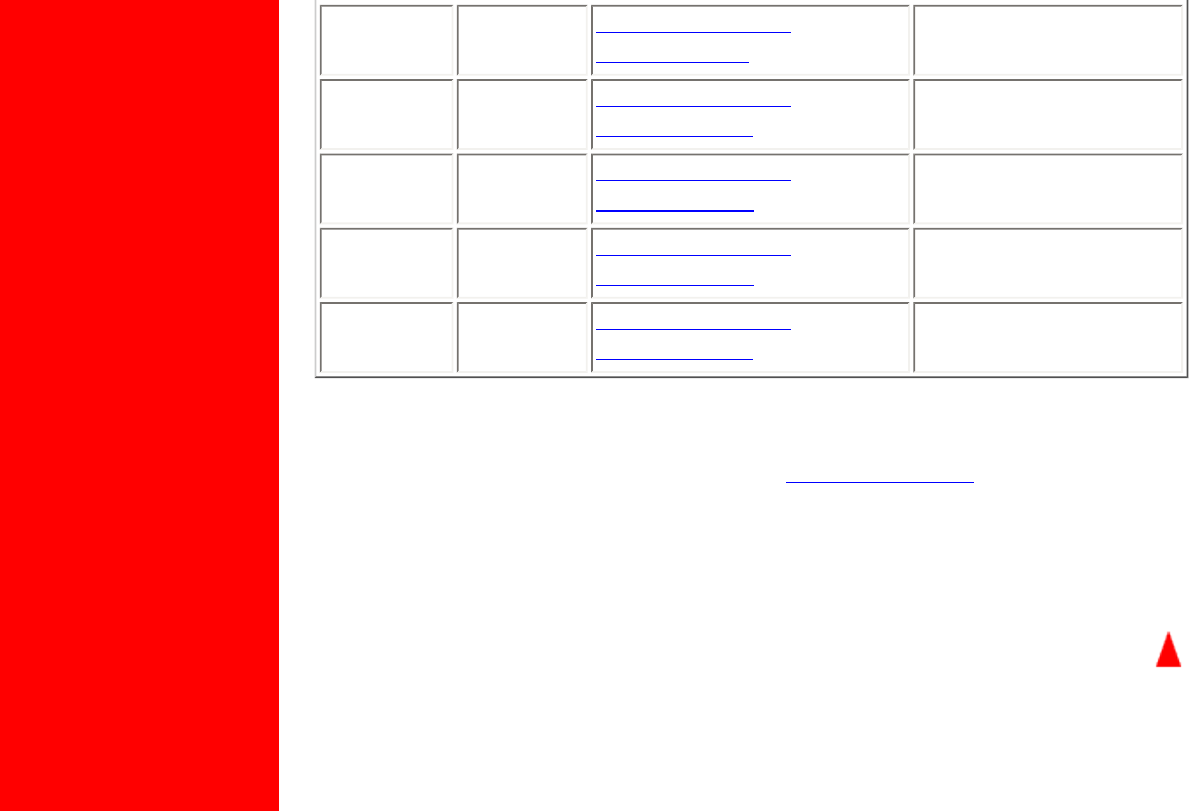
802.11g 54Mbps USB Adapter User Guide
Russia 8-800-200-
200-1
http://www.usr.com/
emailsupport/ru 10:00 - 18:00
Monday - Friday
Spain 902 11
7964
http://www.usr.com/
emailsupport/es 9:00 - 17:00
Monday - Friday
Switzerland 0848 840
200
http://www.usr.com/
emailsupport/de 9:00 - 17:00
Monday - Friday
Sweden +46 (0) 77
128 1020
http://www.usr.com/
emailsupport/ea 9:00 - 17:00
Monday - Friday
United
Kingdom 0870 844
4546
http://www.usr.com/
emailsupport/uk 9:00 - 17:00
Monday - Friday
To obtain the most current support information, including procedures to obtain Service
Repair Orders, visit the U.S. Robotics Web site: http://www.usr.com.
file:///C|/Arcadyan/USR/SW/English/five.html 第 5 頁 / 共 5 2004/9/15 下午 05:34:58

802.11g 54Mbps USB Adapter User Guide
Contents:
About the 802.11g
54Mbps USB Adapter
Network Configuration
and Planning
Adapter Installation and
Configuration for
Windows 98SE/2000/
Me/XP
Navigating the Wireless
Configuration Utility
Troubleshooting
Glossary >
Product Specifications
for 802.11g 54Mbps
USB Adapter
U.S. Robotics
Corporation Limited
Warranty
Regulatory Information
802.11g 54Mbps USB Adapter User Guide
Glossary
Access Point A networking device that seamlessly connects wired and wireless
networks together.
Ad Hoc An Ad Hoc wireless LAN is a group of computers, each with wireless
adapters, connected as an independent wireless LAN.
AES AES stands for Advanced Encryption System, which utilizes a
symmetric 128-bit clock data encryption. This is an option within the
WPA-PSK encryption method.
Backbone
This is the core infrastructure of a network, the portion of the
network that transports information from one central location to
another central location. The information is then off-loaded onto a
local system.
Base Station
In mobile telecommunication, a base station is the central radio
transmitter/receiver that maintains communication with the mobile
radio telephone sets within range. In cellular and personal
communications applications, each cell or microcell has its own
base station; each base station in turn is interconnected with other
cells' bases.
Bridge An internetworking function that incorporates the lowest two layers
of the OSI network protocol model.
BSS An acronym for Basic Service Set, this is an Access Point that is
associated with several wireless stations.
ESS An acronym for Extended Service Set, this is a roaming domain.
More than one BSS can be configured as an Extended Service Set.
Ethernet
A popular local area data communications network that accepts
transmission from computers and terminals. An Ethernet operates
on a 10-Mbps baseband transmission over shielded coaxial cable or
over shielded, twisted-pair telephone wire.
Infrastructure
This is an integrated wireless and wired LAN configuration. In this
type of setup, a wireless network is created by wireless adapters
connecting to a wireless router or access point. The wireless router
or access point can be connected to a broadband modem or to an
existing LAN to supply Internet connectivity to the wireless network.
file:///C|/Arcadyan/USR/SW/English/six.html 第 1 頁 / 共 2 2004/9/15 下午 05:34:59

802.11g 54Mbps USB Adapter User Guide
Roaming
A function that allows one to travel with a mobile end system
(wireless LAN mobile station, for example) through the territory of a
domain (an ESS, for example) while continuously connecting to the
infrastructure.
SSID SSID stands for Service Set Identifier. This is the network name that
is used to identify a specific wireless network.
PSK PSK stands for Pre Shared Key. This is an element of the WPA
encryption standard.
TKIP
TKIP stands for Temporal Key Integrity Protocol. TKIP utilizes a
stronger encryption method and incorporates Message Integrity
Code (MIC) to provide protection against hackers. This is an option
within the WPA-PSK encryption method.
WEP WEP stands for Wired Equivaent Privacy. This is an encryption
standard that provides a level of security and privacy that is
comparable to what is usually expected of a wired LAN.
WPA WPA stands for Wi-Fi Protected Access. This is an encryption
standard that is an improvement on the WEP standard. WPA
provides more sophisticated encryption and user authentication.
file:///C|/Arcadyan/USR/SW/English/six.html 第 2 頁 / 共 2 2004/9/15 下午 05:34:59

802.11g 54Mbps USB Adapter User Guide
Contents:
About the 802.11g
54Mbps USB Adapter
Network Configuration
and Planning
Adapter Installation
and Configuration for
Windows 98SE/2000/
Me/XP
Navigating the
Wireless
Configuration Utility
Troubleshooting
Glossary
Product Specifications
for 802.11g 54Mbps
USB Adapter >
U.S. Robotics
Corporation Limited
Warranty
Regulatory Information
802.11g 54Mbps USB Adapter User Guide
Product Specifications for the 802.11g 54Mbps
USB Adapter
Radio:Complies with IEEE 802.11g
Frequency Band:
● USA (FCC): 2412 ~ 2462 MHz, Ch1 ~ Ch11
● Canada (IC): 2412 ~ 2462 MHz, Ch1 ~ Ch11
● Europe (ETSI): 2412 ~ 2472 MHz, Ch1 ~ Ch13
Modulation Type:CCK, OFDM
Operating Channels:
● 11 channels (US, Canada)
● 13 channels (ETSI)
Radio Technology:Direct Sequence Spread Spectrum (DSSS)
Data Rate:54/48/36/24/18/12/11/9/6/5.5/2/1 Mbps with auto fallback
Output Power:+16dBm max.
Receive sensitivity:-92dBm max.
Antenna Type:Integrated antenna
Current Consumption:
455mA (TX)
330mA (RX)
Interface: USB Type 2.0 compliant, backward compatible with USB1.1
LED: (WLAN TX/RX)
Package:USB
Certification:
● FCC Part 15
● ETSI 300.328
● ARIB STD33 & T66
file:///C|/Arcadyan/USR/SW/English/seven.html 第 1 頁 / 共 2 2004/9/15 下午 05:34:59

802.11g 54Mbps USB Adapter User Guide
Contents:
About the 802.11g
54Mbps USB Adapter
Network Configuration
and Planning
Adapter Installation and
Configuration for
Windows 98SE/2000/
Me/XP
Navigating the Wireless
Configuration Utility
Troubleshooting
Glossary
Product Specifications
for 802.11g 54Mbps
USB Adapter
U.S. Robotics
Corporation Limited
Warranty >
Regulatory Information
802.11g 54Mbps USB Adapter User Guide
U.S. Robotics Corporation Two (2) Year
Limited Warranty
1.0 GENERAL TERMS:
1.1 This Limited Warranty is extended only to the original end-user purchaser
(CUSTOMER) and is not transferable.
1.2 No agent, reseller, or business partner of U.S. Robotics Corporation (U.S.
ROBOTICS) is authorised to modify the terms of this Limited Warranty on behalf of U.S.
ROBOTICS.
1.3 This Limited Warranty expressly excludes any product that has not been purchased
as new from U.S. ROBOTICS or its authorised reseller.
1.4 This Limited Warranty is only applicable in the country or territory where the product
is intended for use (As indicated by the Product Model Number and any local
telecommunication approval stickers affixed to the product).
1.5 U.S. ROBOTICS warrants to the CUSTOMER that this product will be free from
defects in workmanship and materials, under normal use and service, for TWO (2)
YEARS from the date of purchase from U.S. ROBOTICS or its authorised reseller.
1.6 U.S. ROBOTICS sole obligation under this warranty shall be, at U.S. ROBOTICS
sole discretion, to repair the defective product or part with new or reconditioned parts; or
to exchange the defective product or part with a new or reconditioned product or part
that is the same or similar; or if neither of the two foregoing options is reasonably
available, U.S. ROBOTICS may, at its sole discretion, provide a refund to the
CUSTOMER not to exceed the latest published U.S. ROBOTICS recommended retail
purchase price of the product, less any applicable service fees. All products or parts that
are exchanged for replacement will become the property of U.S. ROBOTICS.
1.7 U.S. ROBOTICS warrants any replacement product or part for NINETY (90) DAYS
from the date the product or part is shipped to Customer.
1.8 U.S. ROBOTICS makes no warranty or representation that this product will meet
CUSTOMER requirements or work in combination with any hardware or software
products provided by third parties.
1.9 U.S. ROBOTICS makes no warranty or representation that the operation of the
software products provided with this product will be uninterrupted or error free, or that all
defects in software products will be corrected.
1.10 U.S. ROBOTICS shall not be responsible for any software or other CUSTOMER
data or information contained in or stored on this product.
2.0 CUSTOMER OBLIGATIONS
2.1 CUSTOMER assumes full responsibility that this product meets CUSTOMER
specifications and requirements.
2.2 CUSTOMER is specifically advised to make a backup copy of all software provided
with this product.
2.3 CUSTOMER assumes full responsibility to properly install and configure this product
file:///C|/Arcadyan/USR/SW/English/eight.html 第 1 頁 / 共 4 2004/9/15 下午 05:35:00

802.11g 54Mbps USB Adapter User Guide
and to ensure proper installation, configuration, operation and compatibility with the
operating environment in which this product is to function.
2.4 CUSTOMER must furnish U.S. ROBOTICS a dated Proof of Purchase (copy of
original purchase receipt from U.S. ROBOTICS or its authorised reseller) for any
warranty claims to be authorised.
3.0 OBTAINING WARRANTY SERVICE:
3.1 CUSTOMER must contact U.S. ROBOTICS Technical Support or an authorised U.S.
ROBOTICS Service Centre within the applicable warranty period to obtain warranty
service authorisation.
3.2 Customer must provide Product Model Number, Product Serial Number and dated
Proof of Purchase (copy of original purchase receipt from U.S. ROBOTICS or its
authorised reseller) to obtain warranty service authorisation.
3.3 For information on how to contact U.S. ROBOTICS Technical Support or an
authorised U.S. ROBOTICS Service Centre, please see the U.S ROBOTICS corporate
Web site at: www.usr.com
3.4 CUSTOMER should have the following information / items readily available when
contacting U.S. ROBOTICS Technical Support:
· Product Model Number
· Product Serial Number
· Dated Proof of Purchase
· CUSTOMER contact name & telephone number
· CUSTOMER Computer Operating System version
· U.S. ROBOTICS Installation CD-ROM
· U.S. ROBOTICS Installation Guide
4.0 WARRANTY REPLACEMENT:
4.1 In the event U.S. ROBOTICS Technical Support or its authorised U.S. ROBOTICS
Service Centre determines the product or part has a malfunction or failure attributable
directly to faulty workmanship and/or materials; and the product is within the TWO (2)
YEAR warranty term; and the CUSTOMER will include a copy of the dated Proof of
Purchase (original purchase receipt from U.S. ROBOTICS or its authorised reseller) with
the product or part with the returned product or part, then U.S. ROBOTICS will issue
CUSTOMER a Return Material Authorisation (RMA) and instructions for the return of the
product to the authorised U.S. ROBOTICS Drop Zone.
4.2 Any product or part returned to U.S. ROBOTICS without an RMA issued by U.S.
ROBOTICS or its authorised U.S. ROBOTICS Service Centre will be returned.
4.3 CUSTOMER agrees to pay shipping charges to return the product or part to the
authorised U.S. ROBOTICS Return Centre; to insure the product or assume the risk of
loss or damage which may occur in transit; and to use a shipping container equivalent to
the original packaging.
4.4 Responsibility for loss or damage does not transfer to U.S. ROBOTICS until the
returned product or part is received as an authorised return at an authorised U.S.
ROBOTICS Return Centre.
4.5 Authorised CUSTOMER returns will be unpacked, visually inspected, and matched
to the Product Model Number and Product Serial Number for which the RMA was
authorised. The enclosed Proof of Purchase will be inspected for date of purchase and
place of purchase. U.S. ROBOTICS may deny warranty service if visual inspection of the
returned product or part does not match the CUSTOMER supplied information for which
the RMA was issued.
4.6 Once a CUSTOMER return has been unpacked, visually inspected, and tested U.S.
ROBOTICS will, at its sole discretion, repair or replace, using new or reconditioned
product or parts, to whatever extent it deems necessary to restore the product or part to
operating condition.
4.7 U.S. ROBOTICS will make reasonable effort to ship repaired or replaced product or
part to CUSTOMER, at U.S. ROBOTICS expense, not later than TWENTY ONE (21)
DAYS after U.S. ROBOTICS receives the authorised CUSTOMER return at an
file:///C|/Arcadyan/USR/SW/English/eight.html 第 2 頁 / 共 4 2004/9/15 下午 05:35:00

802.11g 54Mbps USB Adapter User Guide
authorised U.S. ROBOTICS Return Centre.
4.8 U.S. ROBOTICS shall not be liable for any damages caused by delay in delivering or
furnishing repaired or replaced product or part.
5.0 LIMITATIONS
5.1 THIRD-PARTY SOFTWARE: This U.S. ROBOTICS product may include or be
bundled with third-party software, the use of which is governed by separate end-user
license agreements provided by third-party software vendors. This U.S. ROBOTICS
Limited Warranty does not apply to such third-party software. For the applicable warranty
refer to the end-user license agreement governing the use of such software.
5.2 DAMAGE DUE TO MISUSE, NEGLECT, NON-COMPLIANCE, IMPROPER
INSTALLATION, AND/OR ENVIRONMENTAL FACTORS: To the extent permitted by
applicable law, this U.S. ROBOTICS Limited Warranty does not apply to normal wear
and tear; damage or loss of data due to interoperability with current and/or future
versions of operating system or other current and/or future software and hardware;
alterations (by persons other than U.S. ROBOTICS or authorised U.S. ROBOTICS
Service Centres); damage caused by operator error or non-compliance with instructions
as set out in the user documentation or other accompanying documentation; damage
caused by acts of nature such as lightning, storms, floods, fires, and earthquakes, etc.
Products evidencing the product serial number has been tampered with or removed;
misuse, neglect, and improper handling; damage caused by undue physical,
temperature, or electrical stress; counterfeit products; damage or loss of data caused by
a computer virus, worm, Trojan horse, or memory content corruption; failures of the
product which result from accident, abuse, misuse (including but not limited to improper
installation, connection to incorrect voltages, and power points); failures caused by
products not supplied by U.S. ROBOTICS; damage cause by moisture, corrosive
environments, high voltage surges, shipping, abnormal working conditions; or the use of
the product outside the borders of the country or territory intended for use (As indicated
by the Product Model Number and any local telecommunication approval stickers affixed
to the product).
5.3 TO THE FULL EXTENT ALLOWED BY LAW, THE FOREGOING WARRANTIES
AND REMEDIES ARE EXCLUSIVE AND ARE IN LIEU OF ALL OTHER WARRANTIES,
TERMS, OR CONDITIONS, EXPRESS OR IMPLIED, EITHER IN FACT OR BY
OPERATION OF LAW, STATUTORY OR OTHERWISE, INCLUDING WARRANTIES,
TERMS, OR CONDITIONS OF MERCHANTABILITY, FITNESS FOR A PARTICULAR
PURPOSE, SATISFACTORY QUALITY, CORRESPONDENCE WITH DESCRIPTION,
AND NON-INFRINGEMENT, ALL OF WHICH ARE EXPRESSLY DISCLAIMED. U.S.
ROBOTICS NEITHER ASSUMES NOR AUTHORISES ANY OTHER PERSON TO
ASSUME FOR IT ANY OTHER LIABILITY IN CONNECTION WITH THE SALE,
INSTALLATION, MAINTENANCE, WARRANTY, OR USE OF ITS PRODUCTS.
5.4 LIMITATION OF LIABILITY. TO THE FULL EXTENT ALLOWED BY LAW, U.S.
ROBOTICS ALSO EXCLUDES FOR ITSELF AND ITS SUPPLIERS ANY LIABILITY,
WHETHER BASED IN CONTRACT OR TORT (INCLUDING NEGLIGENCE), FOR
INCIDENTAL, CONSEQUENTIAL, INDIRECT, SPECIAL, OR PUNITIVE DAMAGES OF
ANY KIND, OR FOR LOSS OF REVENUE OR PROFITS, LOSS OF BUSINESS, LOSS
OF INFORMATION OR DATA, OR OTHER FINANCIAL LOSS ARISING OUT OF OR IN
CONNECTION WITH THE SALE, INSTALLATION, MAINTENANCE, USE,
PERFORMANCE, FAILURE, OR INTERRUPTION OF ITS PRODUCTS, EVEN IF U.S.
ROBOTICS OR ITS AUTHORISED RESELLER HAS BEEN ADVISED OF THE
POSSIBILITY OF SUCH DAMAGES, AND LIMITS ITS LIABILITY TO REPAIR,
REPLACEMENT, OR REFUND OF THE PURCHASE PRICE PAID, AT U.S. ROBOTICS
OPTION. THIS DISCLAIMER OF LIABILITY FOR DAMAGES WILL NOT BE
AFFECTED IF ANY REMEDY PROVIDED HEREIN SHALL FAIL OF ITS ESSENTIAL
PURPOSE.
6.0 DISCLAIMER: Some countries, states, territories or provinces do not allow the
exclusion or limitation of implied warranties or the limitation of incidental or consequential
file:///C|/Arcadyan/USR/SW/English/eight.html 第 3 頁 / 共 4 2004/9/15 下午 05:35:00

802.11g 54Mbps USB Adapter User Guide
damages for certain products supplied to consumers, or the limitation of liability for
personal injury, so the above limitations and exclusions may be limited in their
application to CUSTOMER. When the implied warranties are not allowed by law to be
excluded in their entirety, they will be limited to the TWO (2) YEAR duration of this
written warranty. This warranty gives CUSTOMER specific legal rights, which may vary
depending on local law.
7.0 GOVERNING LAW: This Limited Warranty shall be governed by the laws of the
State of Illinois, U.S.A. excluding its conflicts of laws principles and excluding the United
Nations Convention on Contracts for the International Sale of Goods.
U.S. Robotics Corporation
935 National Parkway
Schaumburg, IL 60173
U.S.A
file:///C|/Arcadyan/USR/SW/English/eight.html 第 4 頁 / 共 4 2004/9/15 下午 05:35:00
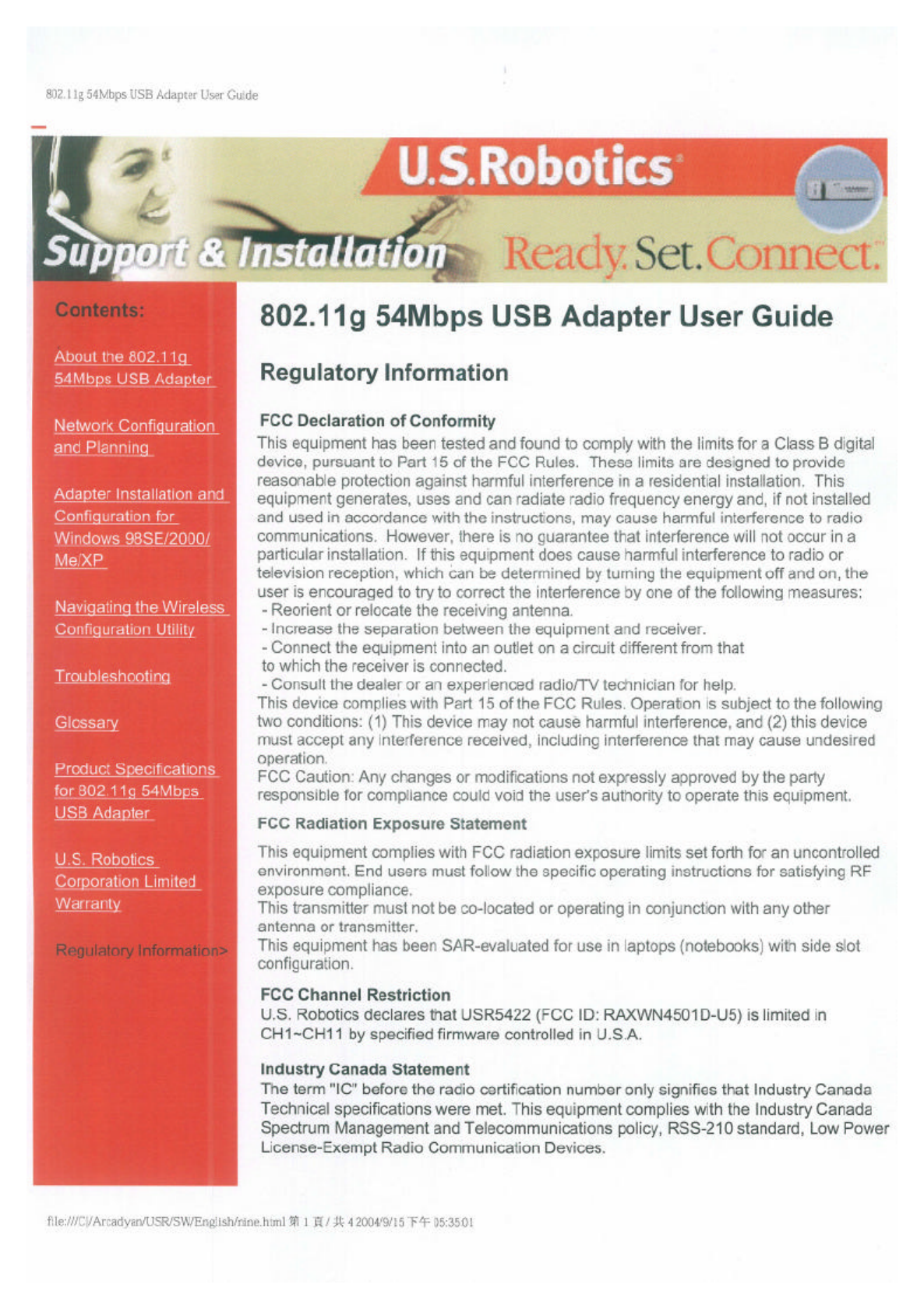
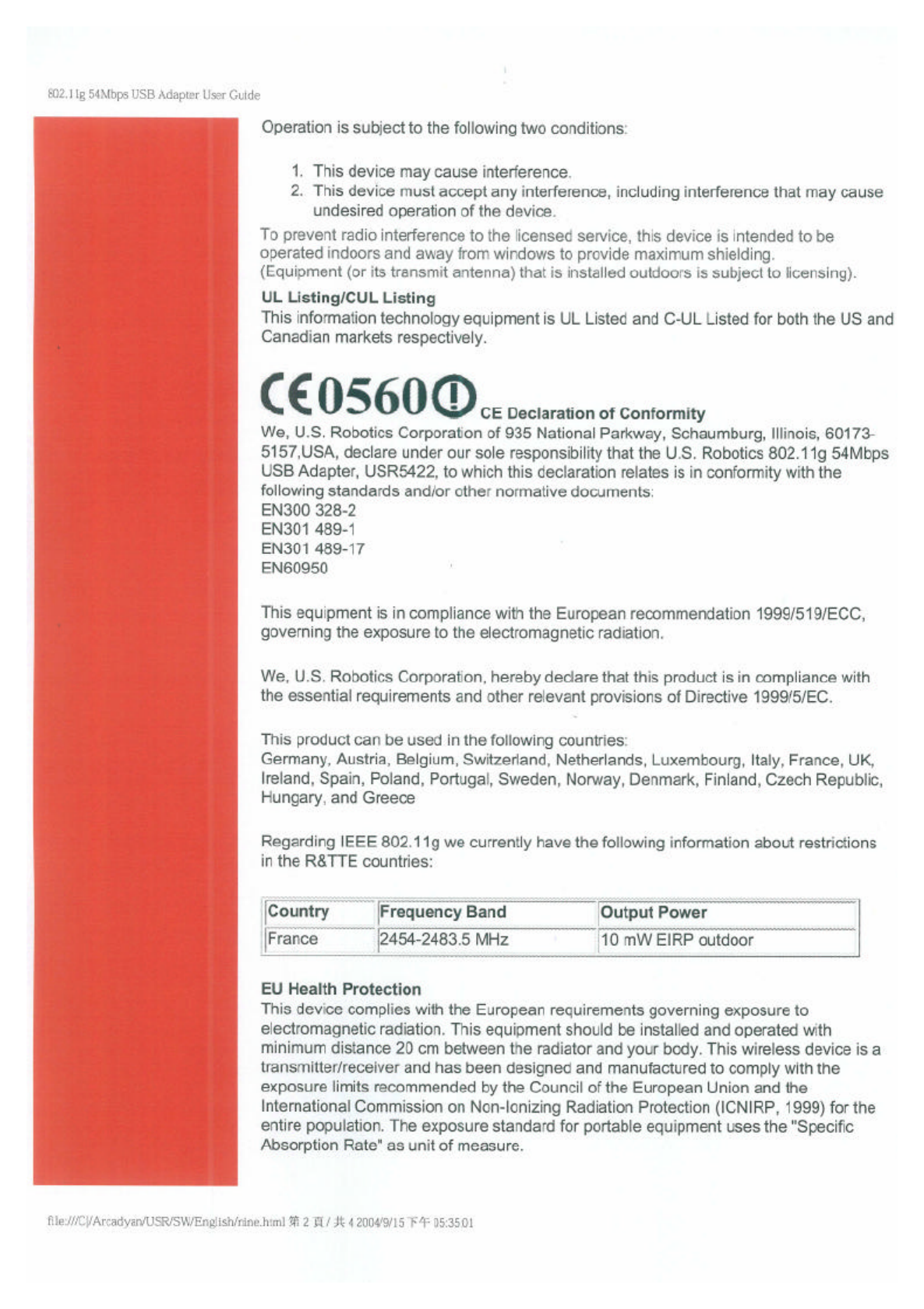

802.11g 54Mbps USB Adapter User Guide
Operating Channels:
● IEEE 802.11g compliant
● 11 channels (US, Canada)
● 13 channels (ETSI)
Regulatory Channel Frequency
Channel Frequency (MHz) FCC Canada ETSI
1 2412 X X X
2 2417 X X X
3 2422 X X X
4 2427 X X X
5 2432 X X X
6 2437 X X X
7 2442 X X X
8 2447 X X X
9 2452 X X X
10 2457 X X X
11 2462
X X X
12 2467 X
13 2472 X
14 2484
Go to www.usr.com to see the most recent channel restriction information.
Manufacturer's Disclaimer Statement
The information in this document is subject to change without notice and does not
represent a commitment on the part of the vendor. No warranty or representation, either
expressed or implied, is made with respect to the quality, accuracy or fitness for any
particular purpose of this document. The manufacturer reserves the right to make
changes to the content of this document and/or the products associated with it at any
time without obligation to notify any person or organisation of such changes. In no event
will the manufacturer be liable for direct, indirect, special, incidental or consequential
damages arising out of the use or inability to use this product or documentation, even if
advised of the possibility of such damages. This document contains materials protected
by copyright. All rights are reserved. No part of this manual may be reproduced or
transmitted in any form, by any means or for any purpose without expressed written
consent of its authors. Product names appearing in this document are mentioned for
identification purchases only. All trademarks, product names or brand names appearing
in this document are registered property of their respective owners.
file:///C|/Arcadyan/USR/SW/English/nine.html 第 3 頁 / 共 4 2004/9/15 下午 05:35:01

802.11g 54Mbps USB Adapter User Guide
Please contact our support center for an RMA number before sending your product to
the repair address. Product sent to the repair address without an RMA number will be
returned unopened.
In North America:
U.S. Robotics
c/o Innovate -It
935 McLaughlin
San Jose, CA 95122
United States
In Europe:
FRS Europe BV.
Draaibrugweg 2
1332 AC Almer
The Netherlands
In Canada:
U.S.Robotics
Unit-100
13751 Mayfield Place
Richmond, B.C.Canada V6V 2G9
file:///C|/Arcadyan/USR/SW/English/nine.html 第 4 頁 / 共 4 2004/9/15 下午 05:35:01

